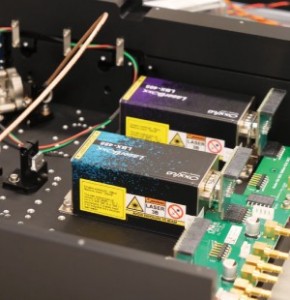
Transparent displays have a variety of potential applications, such as the ability to see navigation or dashboard information while looking through the windshield of a car or plane or to project video onto a window or a pair of eyeglasses. A number of technologies have been developed for such displays, but all have limitations.
Now, researchers at the Massachusetts Institute of Technology (MIT) have come up with a new approach that can have significant advantages over existing systems, at least for certain kinds of applications: a wide viewing angle, simplicity of manufacture and, potentially, low cost and scalability.
The innovative system is described in the paper, “Transparent displays enabled by resonant nanoparticle scattering,“ published this week in the journal Nature Communications, co-authored by MIT professors Marin Soljačić and John Joannopoulos, graduate student Chia Wei Hsu, and four others.
Many current “head-up” display systems use a mirror or beam splitter to project an image directly into the user’s eyes, making it appear that the display is hovering in space somewhere in front of him. But such systems are extremely limited in their angle of view: The eyes must be in exactly the right position in order to see the image at all. With the new system, the image appears on the glass itself and can be seen from a wide array of angles.
Other transparent displays use electronics directly integrated into the glass: organic light-emitting diodes (OLEDs) for the display and transparent electronics to control them. But such systems are complex and expensive and their transparency is limited.
In the new system nanoparticles are embedded in the transparent material. These tiny particles can be tuned to scatter only certain wavelengths, or colours, or light while letting all the rest pass right through. That means the glass remains transparent enough to see colours and shapes clearly through it, while a single-colour display is clearly visible on the glass.
To demonstrate the system, the team projected a blue image in front of a scene containing cups of several colours, all of which can clearly be seen through the projected image.
Video credit to Melanie Gonick, MIT News Service
While the team’s demonstration used silver nanoparticles, each about 60 nanometres (nm) across, that produce a blue image, they say it should be possible to create full-colour display images using the same technique. Three colours (red, green and blue) are enough to produce what we perceive as full-colour and each of the three colours would still show only a very narrow spectral band, allowing all other hues to pass through freely.
According to Prof. Soljačić, the nanoparticle scattering enables you to see the projected image in a way similar to the way that smoke in the air can reveal the presence of a laser beam passing through it. Such displays might be used, for example, to project images onto store windows while still allowing passersby to see clearly the merchandise on display inside, or to provide heads-up windshield displays for drivers or pilots, regardless of viewing angle.
Soljačić says that his group’s demonstration is just a proof-of-concept and that much work remains to optimise the performance of the system. Silver nanoparticles, which are commercially available, were selected for the initial testing because using them was simple and cheap. The team achieved promising results even without any attempt to optimise the materials,
The particles could be incorporated in a thin, inexpensive plastic coating applied to the glass, in much the same was that tinting is applied to car windows. This would work with commercially available laser projectors or conventional projectors that produce the specified colour.
The work, which also included MIT graduate student Bo Zhen, recent PhD recipient Wenjun Qiu, MIT affiliate Ofer Shapira, and Brendan Lacey of the US Army Edgewood Chemical Biological Center, was supported by the US Army Research Office and the US National Science Foundation.































 Back to News
Back to News



























